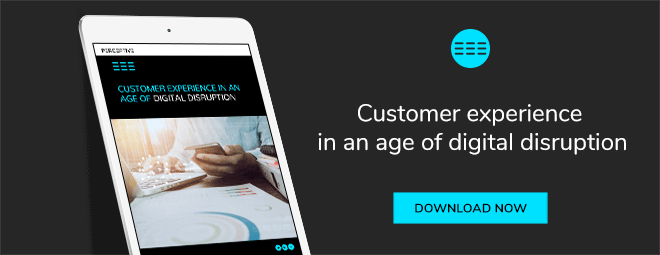Today, digital forms an integral part of companies—as much as HR or sales, if not more. Digital channels and technology such as mobile, the cloud, gamification, cognitive computing, social media, and most recently generative AI, have disrupted the customer experience completely. So much so, that we should regard every customer as a digital customer.
This trend affects every industry, albeit some more so than others. A report from CBInsights concludes that the industries that can anticipate the most digital disruption are healthcare, education, manufacturing, retail, finance, security, entertainment and food services.
These industries owe much of their disruption to Covid-19 as the pandemic pushed services that were traditionally brick and mortar to venture online, from telehealth and eCommerce to automation, contactless payments, and increased data protection and cyber security measures.
Digital disruption creates a lot of opportunities, however, it also presents new challenges, which we’ll touch upon here.
Related content: The Future of Business: data and digital transformation
Facing the technology challenge
Today, the issue isn't lack of information, but too much of it. Data comes at us all at the same time. Information overload, in other words, is the technology challenge. This is true for consumers as well as professional organisations.
While it’s great that we have access to lots of valuable information, too often we have too many systems feeding us too much data, which gets placed in multiple “pockets”. It’s all gets quite siloed. This becomes a challenge when trying to provide a smooth, seamless customer experience across multiple platforms and channels. Ultimately, it ends up frustrating the customer as they re-login here, receive multiple (sometimes duplicate) marketing emails there, and are asked again and again for their preferences. It’s the digital equivalent of your departments not talking to one another.
This, in turn, becomes a content challenge. Your content is all over the place, and what’s worse, because the systems are siloed, you can’t provide a consistent customer experience.
Read more: 5 best practice tips for collecting customer data
Mastering the omnichannel challenge
Another challenge companies are facing today, thanks to digital disruption, is the omnichannel challenge. We are using multiple devices and channels to connect to each other, and to brands, which creates a challenge for any product or service provider.
Being an omnichannel brand means that each of your platforms needs to have awareness of the other. Your website needs to know what experiences a customer has had with your brand’s LinkedIn or Facebook pages; how they have engaged with your different apps, and what kind of in-store digital experiences they’ve had.
Many companies are fairly eloquent at providing multi-channel customer experience (being present on multiple channels), but few are able to truly deliver an omnichannel customer experience. That is, a seamless, personalised journey that endures (and ideally masters) switching in between different digital channels.
Omni-channel experiences are only as good as the data used to shape those experiences. Without insights to guide what kind of content is truly useful and relevant to your customers of a particular channel, it may as well not exist. It’s like creating a website that exclusively sells high heels, but to only write social posts about hiking boots.
At its core, the omnichannel experience is about having consistent and relevant content across all of your channels. This is incredibly important as those channels are where your customers interact with you. Moreover, it also shapes how customers interact with us, which, in many cases, is outside of our control.
3 steps for B2C’s to manage digital disruption
In summary, businesses today need to follow through on these three steps.
1) Get control over your data
Collect and analyse all of your customer data in one single place, through a dynamic platform, so that you never miss any customer interactions. If you can’t do this through one single system, make sure that your systems are speaking to each other, and feeding data into a single interface.
2) Relevancy
Ensure your marketing and post-sales communications are relevant and personalised (which can only be executed by following through on the previous step). Understanding your customers is key here; collecting customer feedback and being proactive in managing it is imperative for success.
3) Automation
Through an automated platform, you can make sure that your data is shaping your customer experiences across different channels and types of interactions.
3 steps to help B2B’s manage digital disruption
You might assume that most of these challenges are mainly relevant to B2C companies. However, digital disruption applies to all organisations today; it affects B2Bs just as much. And companies are clueing up on the issue and what needs to be done about it.
According to Forrester, many B2Bs believe that omnichannel investment is crucial to serving the customers of today (87 per cent), to be successful in the longer term (86 per cent), and to drive sales and profit (83 per cent).
For B2Bs, the challenge of sharing and accessing customer data and analytics remains, especially between channels, and countries or locations. Forty-two per cent of B2B companies mention this as a particular challenge they’re facing.
1) Let customer behaviour inform decision making
Again, here it’s essential to use customer behaviour to help resolve the issues B2B businesses struggle with, such as organisational structure. This came up frequently in the aforementioned study; the conflict between channel organisations, limited staff skills and internal resistance from employees and management was a key point.
Letting customer insights (rather than internal legacy structures) lead and inform business decisions, means B2B’s are better armed to overcome these organisational challenges.
2) Break down organisational silos
Now more than ever, it’s vital to have the knowledge and the means to break down business process barriers. Breaking down the silos between existing channels and becoming more intuitive and automated when sharing information is paramount. Without this, B2Bs cannot deliver the omnichannel features (such as personalisation and cross-channel visibility) that buyers have come to expect, further diminishing your brand in their eyes.
3) Anticipate customer needs
Savvy businesses are clued up on what to do to ensure omnichannel expectations are met for their customers. Nearly two-thirds of B2B businesses (62 per cent) in the Forrester study have identified automated price optimisation and personal recommendations as high on their investment agenda. Being able to anticipate your customers’ needs, and rise to them, is what will bring you customer experience success.
Learn how your business can rise above digital disruption and create exceptional online experiences for your customers in our free Digital disruption eBook.

